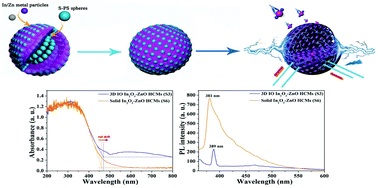Our official English website, www.x-mol.net, welcomes your feedback! (Note: you will need to create a separate account there.)
Rational design of 3D inverse opal heterogeneous composite microspheres as excellent visible-light-induced NO2 sensors at room temperature†
Nanoscale ( IF 6.7 ) Pub Date : 2018-02-09 00:00:00 , DOI: 10.1039/c7nr08366a Tianshuang Wang 1, 2, 3, 4, 5 , Qi Yu 1, 2, 3, 4, 5 , Sufang Zhang 1, 2, 3, 4, 5 , Xueying Kou 1, 2, 3, 4, 5 , Peng Sun 1, 2, 3, 4, 5 , Geyu Lu 1, 2, 3, 4, 5
Nanoscale ( IF 6.7 ) Pub Date : 2018-02-09 00:00:00 , DOI: 10.1039/c7nr08366a Tianshuang Wang 1, 2, 3, 4, 5 , Qi Yu 1, 2, 3, 4, 5 , Sufang Zhang 1, 2, 3, 4, 5 , Xueying Kou 1, 2, 3, 4, 5 , Peng Sun 1, 2, 3, 4, 5 , Geyu Lu 1, 2, 3, 4, 5
Affiliation

|
The lower gas sensitivity, humidity dependence of the gas sensing properties, and long recovery times of room-temperature gas sensors severely limit their applications. Herein, to address these issues, a series of 3D inverse opal (IO) In2O3–ZnO heterogeneous composite microspheres (HCMs) are fabricated by ultrasonic spray pyrolysis (USP) employing self-assembled sulfonated polystyrene (S-PS) spheres as a sacrificial template. The 3D IO In2O3–ZnO HCMs possess highly ordered 3D inverse opal structures and bimodal (meso-scale and macro-scale) pores, which can provide large accessible surface areas and rapid mass transfer, resulting in enhanced gas sensing characteristics. Furthermore, the 3D IO architecture and n–n heterojunctions can extend the photoabsorption range to the visible light area, effectively prolonging the lifetimes of photo-generated charge carriers, and can increase separation of visible light-generated charges. As a result, the as-prepared 3D IO In2O3–ZnO HCMs deliver excellent NO2 sensing performance under visible light irradiation at room temperature, such as high sensitivity (Rgas/Rair = 54.3 to 5 ppm NO2), low detection limit (250 ppb), fast recovery time (188 s), excellent selectivity and humidity independence. These enhanced photo-electronic gas sensing properties are attributed to the combination of highly ordered 3D IO microspheres and In2O3–ZnO heterogeneous composites.
中文翻译:

合理设计3D反蛋白石异质复合微球作为室温下出色的可见光诱导NO 2传感器†
较低的气体敏感性,对气体传感特性的湿度依赖性以及室温气体传感器的长恢复时间严重限制了它们的应用。在本文中,为了解决这些问题,使用自组装的磺化聚苯乙烯(S-PS)球作为超声喷涂热解(USP)制备了一系列3D反蛋白石(IO)In 2 O 3 -ZnO异质复合微球(HCM)。牺牲模板。3D IO输入2 O 3–ZnO HCM具有高度有序的3D反蛋白石结构和双峰(中尺度和宏观尺度)孔隙,可提供较大的可及表面积和快速传质,从而增强了气体传感特性。此外,3D IO体系结构和n–n个异质结可以将光吸收范围扩展到可见光区域,有效地延长了光生电荷载流子的寿命,并可以增加可见光生电荷的分离。结果,所制备的3D IO In 2 O 3 -ZnO HCM在室温下可见光照射下具有出色的NO 2感测性能,例如高灵敏度(R气体/ R空气)。= 54.3至5 ppm NO 2),低检测限(250 ppb),快速恢复时间(188 s),出色的选择性和湿度依赖性。这些增强的光电气体传感特性归因于高度有序的3D IO微球和In 2 O 3 -ZnO异质复合材料的结合。
更新日期:2018-02-09
中文翻译:

合理设计3D反蛋白石异质复合微球作为室温下出色的可见光诱导NO 2传感器†
较低的气体敏感性,对气体传感特性的湿度依赖性以及室温气体传感器的长恢复时间严重限制了它们的应用。在本文中,为了解决这些问题,使用自组装的磺化聚苯乙烯(S-PS)球作为超声喷涂热解(USP)制备了一系列3D反蛋白石(IO)In 2 O 3 -ZnO异质复合微球(HCM)。牺牲模板。3D IO输入2 O 3–ZnO HCM具有高度有序的3D反蛋白石结构和双峰(中尺度和宏观尺度)孔隙,可提供较大的可及表面积和快速传质,从而增强了气体传感特性。此外,3D IO体系结构和n–n个异质结可以将光吸收范围扩展到可见光区域,有效地延长了光生电荷载流子的寿命,并可以增加可见光生电荷的分离。结果,所制备的3D IO In 2 O 3 -ZnO HCM在室温下可见光照射下具有出色的NO 2感测性能,例如高灵敏度(R气体/ R空气)。= 54.3至5 ppm NO 2),低检测限(250 ppb),快速恢复时间(188 s),出色的选择性和湿度依赖性。这些增强的光电气体传感特性归因于高度有序的3D IO微球和In 2 O 3 -ZnO异质复合材料的结合。



























 京公网安备 11010802027423号
京公网安备 11010802027423号